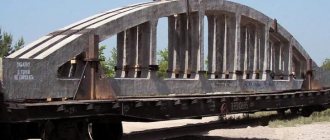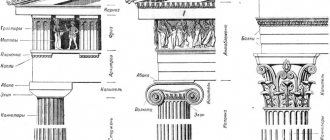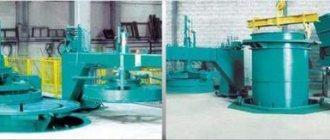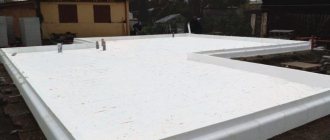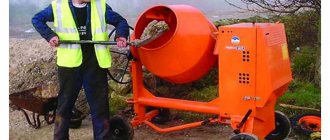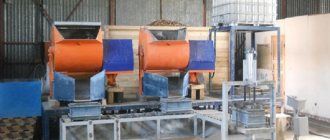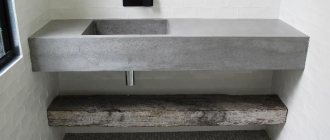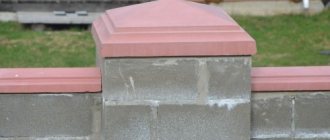What do reinforced concrete fence posts and power line supports have in common? What and how are these structures made of? We will answer these and other questions within the framework of this article.
It is enough to leave the house, look around and you will probably notice that we are surrounded by many pillars and other structures, the main function of which is to hold certain communications, structures, etc.
Cross-section of a trellis post made from prestressed reinforced concrete
In the photo - reinforced concrete fence supports
Pillars have been used for a long time and today are made of various materials, which determine the technical and operational qualities of the finished product. The most popular and in demand material for the manufacture of modern poles is concrete reinforced with metal reinforcement.
So, we have come to the answer to the question of what unites the various supports and pillars. All these structures belong to the category of reinforced concrete products (reinforced concrete products). Let's take a closer look at their main characteristics.
Marking of light poles SV
Like other reinforced concrete products, the products have special markings in accordance with the TU standard. Let's look at an example of an alphanumeric designation:
SV 110 -3.5
SV stands for the name of the product - “Vibrated stand”
110 is the height of the product in decimeters. Accordingly, the height of a product with this marking is 11 meters.
3.5 is the maximum permissible design bending moment in the larger plane of rigidity. Measured in tf*m or kN*m
Production
The production of SV light poles is carried out in accordance with technical specifications. They are made from heavy concrete by pouring into molds followed by vibrocompression. The strength of the product is gained in steaming chambers.
Sales in Nizhny Novgorod
You can buy SV light poles in Nizhny Novgorod at. The website shows current prices only for today. When making calculations, take into account possible seasonal price changes (5-10%) and changes in prices for raw materials (cement and reinforcement).
Payment
You can pay for products by bank transfer. Call us or send a request by email and we will prepare a commercial offer for you, draw up an agreement, and calculate the cost of delivery.
Delivery of supports
Delivery of reinforced concrete products throughout Nizhny Novgorod and the region is carried out by various modes of transport. The supports are usually delivered by flatbed trucks. Also, there is a small manipulator carrying 7 racks 9.5 meters long.
Lighting and power line poles have been used since electricity and lighting became commonplace. And, if at first the poles for installing wiring were made mainly of wood, now more technologically advanced materials are used for the production of these structures.
However, this is not surprising, since metal and reinforced concrete supports, in comparison with structures characteristic of the first half of the last century, are becoming taller, stronger and more resistant to significant loads.
Let's consider what the features of modern lighting poles and power lines are, as well as what and how they are made.
Installation of reinforced concrete racks SV
It all starts with marking the power line route and determining the installation points for power line poles. Then wells are drilled for the supports using a crane drilling machine or manually. The depth and diameter of the hole depend on the size of the post, soil category and wind strength.
The third stage is the installation of racks using a truck crane or a BKM manipulator, control of verticality, fixing the base of the supports in the pits and complete backfilling. We mainly use the following supports: SV 95-3 and SV 110-5. Finally, brackets and lamps are hung on the poles and external power lines are laid.
The size and shape of post holes are dug in different ways, which is associated with the type of communication, type of soil and digging methods. But they always try to minimize the volume of excavated soil. The deepening of the supports should prevent them from being released from the ground and falling under the pressure of the wind.
Features of lighting poles and power lines
It is no secret that power lines can be cable (buried in the ground) or overhead. Special reinforced concrete light supports have found widespread use in the construction of overhead power lines.
Installation of reinforced concrete supports can be carried out in those regions where the design air temperature does not fall below -55 °C. This limitation is due to the main features of the production material. Concrete is characterized by the presence of multiple micropores and, as a result, a tendency to destruction during critical temperature fluctuations.
The basis of such structures is a centrifuged or vibrating rack, made using dense heavy cement mortars reinforced with welded metal structures.
Important: Structures erected using centrifuged racks (used for the construction of 35-110 kV power lines) are characterized by particular strength and durability.
Power line supports, in addition to centrifuged and verified racks, may consist of the following structural elements:
- struts;
- consoles;
- support and anchor plates;
- crossbars;
- anchors for fixing guys;
- lower concrete cover (thrust bearing);
- a wide range of metal structures, including cable supports, extension traverses, head brackets, clamps, guys, internal connections, fastening units.
Installation of reinforced concrete supports in the ground is carried out by installing the structure in a pre-drilled cylindrical pit, followed by filling the sand and gravel mixture into the resulting cavities.
In order to ensure the necessary strength of the installation of the structure on soft soils, the underground part of the overhead line supports is strengthened by means of crossbars secured with half-clamps. To fasten suspended metal structures, clamps or through bolts are used.
Main characteristics
Reinforced concrete supports are made using high-quality concrete reinforced with rolled wire and reinforcing bars.
Among the main advantages of these structures, the following qualities should be noted:
- affordable price, in comparison with all-metal analogues;
- corrosion resistance;
- resistance to long-term exposure to chemical reagents;
- resistance to excess humidity;
- resistance to temperature fluctuations.
Important: The main disadvantage of supports made using reinforced concrete is their low strength in accordance with the weight of the structure as a whole. In addition, the high weight and dimensions of such products result in significant expenses during transportation.
Main varieties
In addition to the fact that reinforced concrete lighting poles are widely used, poles for power lines are used.
Such structures are divided into the following categories:
- Intermediate type supports
are used when constructing straight sections of overhead line routes.
In the photo - intermediate type pillars
Such structures are not designed for loads directed along power lines and are used exclusively for the installation of wires and fixing cables. Today, about 80% of all power lines are installed on.
- Anchor-type supports
are used when arranging straight sections of overhead line routes to ensure passage through natural barriers or engineering structures. Also, these poles are widely used in those sections of the route where it is necessary to change the number, brand and cross-section of wires.
In the photo - anchor posts
- Corner supports
are installed in those areas where the route changes its direction. Pillars of this type bear the resulting loads of the gravity of the wires from the intersupport adjacent spans.
If the route is characterized by a small turning angle (no more than 30°), then the loads on the supports are small, and therefore angular intermediate supports can be used. At large angles over 30°, anchor corner supports with a more durable design and anchor fastening of wires are used.
- An end support
is a type of anchor post.
Such structures are located mainly at the beginning and end of power lines. Structures of this type are designed for one-sided loads.
- Special purpose supports
are used to perform special tasks.
Design features
In accordance with the structural features, reinforced concrete supports of overhead lines are divided into the following categories:
- portal with guy wires;
- portal with internal connections without guy wires;
- single- and multi-post with guy wires;
- single and multi-post without guy wires.
Power line installation technology
Depending on the type of power line, the poles can be wooden, reinforced concrete or metal. Parts of the technological process of constructing an overhead power line are preparatory work and the main work is work on the route.
Preparation consists of the following steps:
— production picketing (laying out the centers of the racks and securing them in the ground);
— preparation of the route (demolition of buildings, cutting of clearings);
— surveys of roads and bridge structures;
— supply of materials to procurement points;
— complete construction, assembly and delivery of racks along the route.
Work on the route consists of:
— delivery of reels with wires, insulators, hardware, etc. to the route;
— earthworks;
— final assembly of poles on pickets, their installation;
— hanging electrical wires and cable reinforcement.
Technology for manufacturing overhead line supports from metal-reinforced concrete
So, after we have determined the technical and operational characteristics of reinforced concrete supports intended for laying overhead lines, we will consider the technology of their manufacture using the example of the SV 95 modification.
Step-by-step production instructions. The first - preparatory stage involves the following work.
Preparation of the working mixture:
- Preparation of Portland cement, inert materials, chemicals. additives and water in accordance with the proportions given in the design documentation;
- Dosing of components and loading into a concrete mixer;
- Bringing the mixture to a homogeneous consistency and unloading it into a concrete paver.
Preparation of reinforcing metal structures:
- Trimming reinforcing bars of the required class into pieces of the required size;
- Preparation of anchor heads;
- Formation of contour spirals;
- Forming loops and preparing the ground loop rod.
Preparation of forms:
- Cleaning the internal volume of the mold;
- Lubricating the internal volume with agents that prevent concrete sticking;
- Spiral distribution;
- Carrying out isothermal heating of rods;
- Distribution of heated rods onto pre-laid stops;
- Threading a spiral between the rods and then attaching it to the rods at three points;
- Distribution of liners along the ends of the mold;
- Installation of pipes and technological loops with their obligatory fixation to the internal surfaces of the formwork.
The second stage is production. At this stage, the working mixture is poured and the finished product is formed.
The following work is performed in the process:
- The concrete paver conveyor is installed in the working position and the pre-prepared form is filled with mortar. Filling the form with concrete is carried out by moving the paver along.
- The mixture is compacted using a deep vibrator to prevent the formation of voids.
- Workers with their own hands, using a rule or a trowel, level the surface of the laid material in the mold.
At the third stage, the product is subjected to isothermal treatment.
This is done as follows:
- Thermal insulating material is laid on top of the filled formwork.
- The heating system for the internal volume of the formwork is turned on. The system automatically controls the parameters of temperature, time, etc. Therefore, the influence of the human factor on the quality of the product is minimal.
- The covering material is removed.
At the final stage, the mold is dismantled, the reinforcement is cut, quality is checked and the finished product is shipped to the warehouse.
Equipment for installing power lines
The construction of overhead power lines involves performing the following work using machines:
— earthen for placing racks with foundations;
— assembly and creation of foundations from reinforced concrete and monolithic concrete;
— driving (pressing) piles, installing racks;
— rolling out and lifting electrical wires and guy wires;
— delivery of equipment and materials to the site.
Basically, you can’t do without using:
— vehicles (flatbed cargo trucks, dump trucks and tractors, closed crew trucks, special ones);
— tractors and bulldozers;
— excavators and loaders;
— cranes, including special ones – support installers;
— telescopic towers and hydraulic lifts;
— mobile welding and crimping units;
— pile driving and drilling machines, etc.
Conclusion
So, we have reviewed general information about how the production of reinforced concrete supports is carried out. We also found out what these structures are, what their technical and operational characteristics are.
Are there any questions that require clarification? You can find more useful information by watching the video in this article.
Reinforced concrete light poles
help support various lighting fixtures.
When preparing construction work, it is first necessary to secure a construction site. This work includes selecting the type of lighting device and installation method. Several types of building materials are used as support, including reinforced concrete. The latter is the most stable, but has certain disadvantages. Reinforced concrete structures for external lighting
are very dependent on weather conditions and temperature changes, but have a long service life.
Reinforced concrete light poles have several important advantages that distinguish them from all other types of supporting structures:
- protection against rust, decay and chemicals;
- long service life. If you carry out high-quality installation and transportation, the costs will be low;
- high-level fire protection;
- ease of manufacture, convenient repairability;
- no high costs for any work.
In addition, reinforced concrete lighting stands have certain disadvantages, due to which they may not be suitable for the construction of certain types of objects:
- significant supporting weight makes loading, installation and transportation of elements more difficult and, accordingly, more expensive;
- it is impossible to remove a reinforced concrete column without special transport;
- processing and removal of the pole is very complex and costly;
- lighting poles react very poorly to temperature and any weather changes;
- Reinforced concrete lighting poles are vulnerable to chipping and cracking.
Reinforced concrete supports SV
used for external illumination of streets, sidewalks, industrial areas and highways. They can also be used to illuminate parks and areas near residential buildings.
There are several types of light stands made of reinforced concrete:
- end,
- corner,
- intermediate,
- anchor
When developing light stands for industrial use, tension or frame reinforcement is used.
Light reinforced concrete posts
and are marked depending on the structural mass, reinforcement method and dimensions. In addition, they differ in temperature conditions, level of resistance to cold, moisture absorption capabilities, load and electrical voltage drops.
All information on reinforced concrete street lighting poles was kindly provided by Samara Plant of Reinforced Concrete Products LLC. Here you can buy reinforced concrete products at competitive prices.
Reinforced concrete lighting poles are used in urban and suburban conditions to illuminate streets and highways, sidewalks, warehouse and industrial sites and other objects. Reinforced concrete supports are also used to suspend overhead lines with voltages up to 10 kilovolts. For lines with voltages from 35 kV, supports made of centrifuged concrete are used.
This type of lighting poles is produced in various shapes and sizes by centrifugation or vibration pressing from high quality concrete reinforced with steel wire. Main brands of lighting poles:
- SVN, C (reinforced concrete support has the shape of an octagon). H × M - 9-10.5 meters, weight 810-1700 kilograms;
- SCS, SNTs (ring section). H × M - 9-11 meters, weight 700-1050 kilograms;
- SKTs (reinforced concrete round, conical support). The height of the supports is 9-11 meters, weight is 700-1050 kilograms;
- SV and SNV (trapezoidal section). The height of the supports is 9.5-16.5 meters, weight is 800-3500 kilograms.
Advantages and disadvantages of using reinforced concrete pillars as lighting supports
Reinforced concrete racks as supports for installing lamps have the following advantages:
- Resistance to corrosion, chemical compounds, rotting;
- Fire resistance and seismic resistance;
- Durability. If the production technology of poles, their transportation and installation is followed, they will last more than 50 years;
- Manufacturability;
- Low operating costs;
- Low cost of construction (only cheaper).
Flaws:
- Heavy weight. One support weighs 700 kilograms or more. They are more difficult to load, transport and install;
- Difficult to dismantle. It is not difficult to knock down the support with a tractor or other vehicle, but difficulties arise when releasing the metal frame and subsequent processing of pieces of concrete. In the first case, you need to use an expensive installation, in the second, you have to pay a lot for complete disposal;
- Weak resistance to mechanical loads. Reinforced concrete supports are “afraid” of sudden shocks, impacts and other loads.
Reinforced concrete supports appeared after wooden ones and are now still actively used. However, they are increasingly being replaced, which have more positive properties in comparison.
Production of supports
Reinforced concrete street lighting supports are produced in several stages:
This stage includes cutting reinforcement of a certain class according to standard sizes using special machine equipment, planting anchor heads, winding contour spirals, bending grounding loop rods and loops.
To prepare the concrete mixture, inert components, chemical additives and cement are prepared. All this is poured into a concrete mixer, filled with water and mixing begins. After a few minutes, when the solution has reached the desired consistency, it is poured into the concrete paver.
Special molds are used to produce supports. They are cleaned and lubricated, after which pre-made spirals are placed there. After this, they begin to prepare the rods. They are heated, pulled through the spirals, placed on the mold stops and fixed. Next, the spirals are stretched and attached to the rods in 3 places, liners are fixed at the ends, technological tubes and loops are installed, fixing them to the formwork.
Now it's a matter of small things. Concrete is poured from a concrete paver into molds, compacted using an internal vibrator, and then the surface is leveled using a trowel or other method.
Drying products
The products are covered with polyethylene along the entire length, having previously laid long boards between the filled forms. Then the workpiece heating system is started and after a certain time the film is removed.
The supports are ready. Using a hoist, they are moved to a certain place, stored and checked for quality. Next, the grounding loop rods are welded to them, they are painted, the strength of the concrete is determined, they are marked and stamped. The supports are ready for use and sale.
Requirements for transportation, storage and operation of supports
The following rules for transporting reinforced concrete supports must be observed:
- When unloading and unloading supports, they must not be subjected to jerking, sudden jolts or dropping;
- Slinging must be done in two places, at an equal distance from the center;
- When transporting supports, you need to place boards under them at a distance of 0.5 meters from each other;
- During transportation, reinforced concrete supports must be secured with guy wires;
- When storing supports in a warehouse, it is necessary to install spacers every 5 meters and lay the racks in three rows.
Before starting excavation work, it is necessary to prepare an appropriate project and coordinate it with local authorities. The project must reflect:
- Features of the terrain where the support or supports are planned to be installed;
- Type and type of soil;
- Type of supports used.
After preparing and agreeing on the project, workers go to the site and begin installing the support. Installation of reinforced concrete supports is carried out in the following order:
- Mark the area;
- They dig a trench under the power cable;
- Prepare a hole, meter by meter wide, 120 centimeters deep for support;
- A hole is drilled in the center of the pit, one meter deep, slightly wider than the width of the rack;
- Place the support in the prepared niche, pour some crushed stone onto its bottom and compact it. Then the support is filled to the end, continuing compaction. Before filling the hole, do not forget to center the support.
Sometimes a little cement is poured into the bottom of the hole to create a solid foundation.
Installation of reinforced concrete lighting poles can be done differently. To do this you need:
- Order a truck crane with a drill attachment;
- Drill a hole in the right place, slightly wider than the width of the support and one and a half meters deep;
- Install the support into the drilled hole;
- Fill the hole with sand.
After installing the support, install the brackets, install the lamps, screw in the lamps and connect the lamps to the electrical network. If the support is hollow inside, the cable is inserted into a special hole at the bottom of the support. In other cases, the cable is attached to a pole, or air power is supplied.
Installation of electric poles (supports) on a summer cottage
Low-voltage lines can be laid on poles made of reinforced concrete, metal, solid wood and wood with a stepson. All wood species, excluding larch, are subject to mandatory antiseptic impregnation.
If wooden supports are chosen, their minimum diameter at the top should be:
— for the main line – 140 mm;
- for a branch to the house - 120 mm.
Regarding the burying of pillars in the ground, the PEU does not give clear recommendations and recommends taking into account “local conditions”. But the minimum distances between the support and neighboring objects and communications are clearly indicated:
| Objects | Distances, cm |
| Pipes for water, heat and sewer | 100 |
| Fire hydrant, water stand or well | 200 |
| Power cable unprotected | 100 |
| Power cable with protection | 50 |
Grounding of reinforced concrete supports
On the supports of overhead lines up to 1 kV, it is necessary to install grounding devices designed to protect against lightning overvoltages and re-grounding. Equipment installed on supports must also be grounded; for this purpose, the lamp housings are connected to a grounding loop.
The grounding loop is made of metal pins with a diameter of at least 6 millimeters or metal corners. They are installed in a triangle and connected to each other by a metal strip. The resistance of the grounding device should be no more than 30 ohms.
Rules and regulations for the installation of power lines
Transmission of electricity via overhead lines requires the laying of wires and their reliable fixation over land or water using supports. Electrical wires are attached to the racks using insulators.
Overhead lines are equipped with copper and aluminum bare wires, which are divided into hollow, single-wire or multi-wire. Sometimes steel wires are used in remote places. In any case, they must be strong enough, resistant to external factors and have low resistance
The laying of power lines must be carried out without violating the rules, regulations and requirements specified in the PES (electrical installation rules) and SNiP (building codes and regulations).
Checking the condition of the supports
Maintenance of reinforced concrete supports and their elements is carried out at certain intervals:
- Corrosion of metal parts of reinforced concrete supports - once every three years;
- Cracks appear once every six years, starting from the third year of operation of the support;
- Inspection of bolted connections and nuts of anchor bolts - once every two years (for two years);
- Checking the condition of stepsons and racks - once every 3 years.
In addition, the following are periodically checked, repaired or replaced:
- Lamp;
- Lamps;
- Starter control equipment and “shield”;
- Switching devices in the control room;
- Counters;
- Broken wires.

